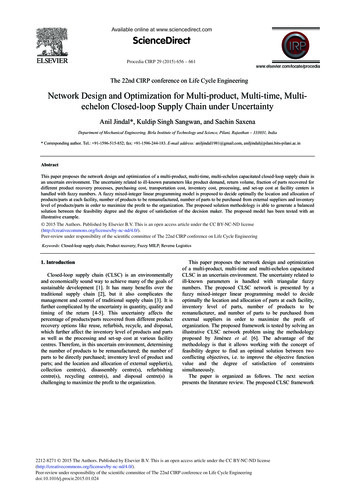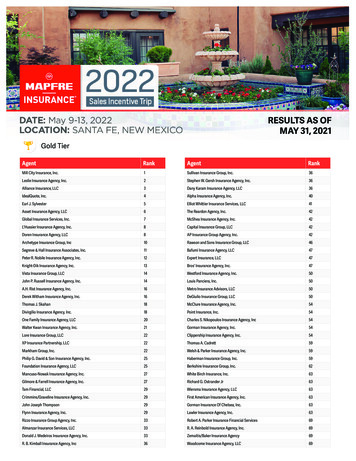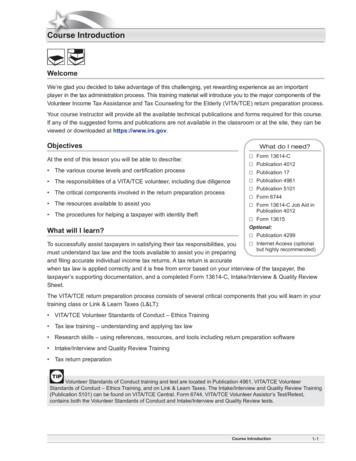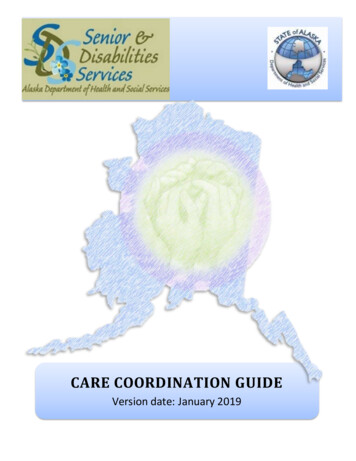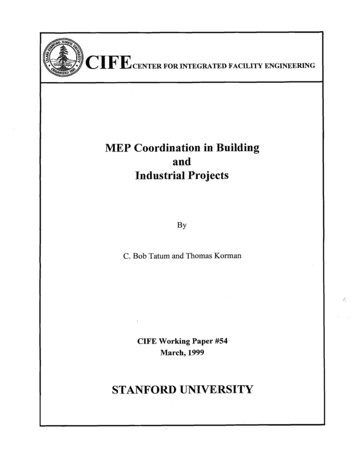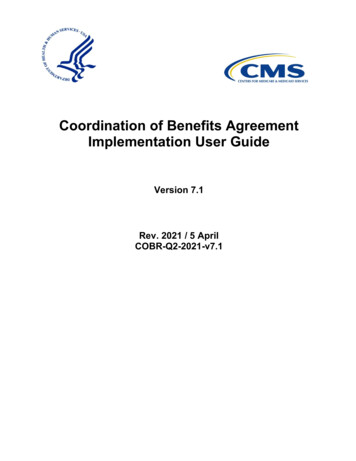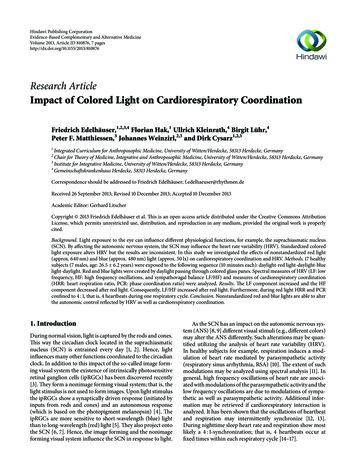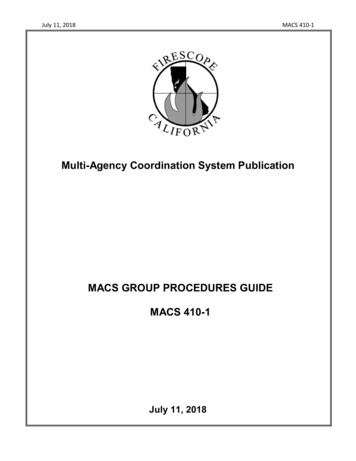
Transcription
July 11, 2018MACS 410-1Multi-Agency Coordination System PublicationMACS GROUP PROCEDURES GUIDEMACS 410-1July 11, 2018
July 11, 2018MACS 410-1NOTICEThis Multi-Agency Coordination System (MACS) 410-1 document establishes MACGroup Procedures specifically intended for use by fire service agencies in Californiarepresented by FIRESCOPE and the California Wildfire Coordinating Group (CWCG).Although this Guide is for the California Fire Service, it is written to support all hazardemergencies and, therefore, has application and utility for the emergencymanagement community.This guide supplements existing agency, state and federal directives and guidelinescurrently in use and complies with the California Standardized EmergencyManagement System (SEMS) and the National Incident Management System (NIMS).This guide describes components of the MACS Information Management System,Modes of Operation, Preparedness Levels and the process and procedures by whichCalifornia Fire Service Multi-Agency Coordination System Groups will function inCalifornia on all hazard incidents that require the use of multi-agency or multidepartment fire service resources on single or multi-jurisdiction incidents.This guide incorporates procedures agreed to by FIRESCOPE and the CaliforniaWildfire Coordinating Group that link the various fire service MAC Groups inCalifornia. Currently these MAC Groups are the Northern California and SouthernCalifornia Geographic Area MAC Groups, and the statewide California MAC Group(CalMAC). Each of the Geographic Area MAC Groups and CalMAC, depending onNational Preparedness Levels, will be required to communicate and coordinate withthe National Wildfire Coordinating Group’s National MAC Group located at theNational Interagency Fire Center in Boise, Idaho. Understanding the MACSorganizational structure is especially important in providing critical incident informationto request and allocate fire based resources to incidents within and outside the Stateof California.Access to the information described in this document is through the FIRESCOPEWebsite at www.firescope.org. Fire agencies with response capability must obtain apassword to fully access the system. For additional information contact the CaliforniaGovernor’s Office of Emergency Services (Cal OES), Fire and Rescue Division,FIRESCOPE Program in Riverside at (951) 782-4174.i
July 11, 2018MACS 410-1CONTENTSINTRODUCTION . 1MAC Group Purpose and Function . 2Local Level and Operational Area MACS . 2Regional Level MACS . 3Geographic Area MACS . 3California Multi-Agency Coordination (CalMAC) . 3CalMAC Role . 4CalMAC Authority . 5CalMAC Responsibilities . 5CalMAC Representatives . 5National Multi-Agency Coordination Group (NMAC) . 6MODES OF OPERATION AND CWCG PREPAREDNESS LEVELS . 7FIRESCOPE MACS Modes of Operation . 7California Wildfire Coordinating Group Preparedness Levels . 7Preparedness Level (PL) Description . 8MAC GROUP MEETINGS . 10Conference Calls . 10In-Person Meetings . 10MAC GROUP REPORTS . 11Agency Resource Status Reports . 11INCIDENT PRIORITY RATING PROCEDURES . 11Incident Priority Rating Matrix . 15APPENDIX A: CalMAC Conference Call Format and Roll Call . A-1APPENDIX B: Briefing Report Format. B-1APPENDIX C: MACS Group Position Duties and Responsibilities . C-1APPENDIX D: MACS Resource Designation SystemForms Packet 400-3 (July 2018) .D-1APPENDIX E: Northern California Geographic Area MAC GroupOperations Guide May 2014. E-1APPENDIX F: Southern California Geographic Area MAC GroupOperations Guide August 2010 . F-1APPENDIX G: California MAC Group Procedures Guide (to be developed) . G-1ii
July 11, 2018MACS 410-1INTRODUCTIONThe Multi-Agency Coordination System (MACS) is a component of the NationalIncident Management System (NIMS), as well as the California StandardizedEmergency Management System (SEMS). It is essential to integrating andcoordinating multi-agency emergency response and management.The function of multi-agency coordination has shown to be most effective when it takesplace in a preplanned and organized Multi-Agency Coordination System. While ad-hocarrangements among agencies can be made to work, it is more effective to establishMACS procedures in advance. A multi-agency coordination system incorporatesfacilities, information systems, internal and external communication systems,interagency reciprocal, and mutual aid agreements, common procedures, terminology,training and qualifications, all integrated into a common operating system that ensureseffective interagency and inter-jurisdictional coordination. Some of the key MACScomponents in the California MACS include the California Mobilization Guide, theFIRESCOPE Field Operations Guide, the FIRESCOPE Radio Frequency Guide, theMACS Resource Designation System, and this MACS Group Procedures Guide. Allprovide important guidance in the development and maintenance of the StatewideMulti-Agency Coordination System. These and many more FIRESCOPE documentsare available on the FIRESCOPE Website at www.firescope.org.This guide will discuss one component of the MAC System, the MAC Group; itsfunction, purpose, membership and organization for the California Fire Service. Alsodiscussed are activation procedures and the processes used to evaluate incidentswith regard to resource allocation and the situation status reports and generalinformation sharing necessary to support the MACS Decision Process. Other itemsdiscussed include support organization requirements. Most importantly this guideestablishes common processes and procedures to ensure information sharing andincident evaluation processes are consistent. Although this guide is directed to thefire service, it has application to all emergency management and is adaptable bysupplementing key resources and information pertinent to specific emergencyrequirements.1
July 11, 2018MACS 410-1MAC Group Purpose and FunctionA MAC Group typically consists of Agency Administrators or their designees who areauthorized to commit agency resources and funds. Their function is to support incidentmanagement through coordinating their collective resources, sharing incidentinformation and, implementing coordinated strategic policies to prevent and/or combat agrowing emergency(s). In order to accomplish this objective the MAC Group mustestablish a common operating plan. The area represented can be a City,County/Operational Area, Region, such as one of the six Cal OES Fire and RescueMutual Aid Regions, a Geographic Area, such as Northern and Southern CaliforniaGeographic Areas or a Statewide MAC Group such as CalMAC.MAC Group objectives in coordinating finance, equipment, personnel and resourcesare: Establish priorities for extended/major incidentsAllocate critical resources based on established prioritiesEstablish and/or implement communication systems integrationEnsure Information coordination both internally and externallyEstablish Intergovernmental decision coordinationDevelop strategies and contingency plansIt is extremely important that MAC Group members have full authority from theirrespective agencies to commit resources and fully represent their agency or departmentin MAC Group decisions.Local Level and Operational Area MACSMulti-agency coordination is an essential element in support of jurisdictional EmergencyOperations Centers (EOC). The local or operational area MAC Group providesjurisdictional or area-wide direction and/or policy. The MAC Group also determinespriorities for the allocation of resources within a defined geographic area. MAC Groupintelligence gathering and information exchange activities are usually accomplishedthrough the information systems established by the EOC, such as the use of the MACSForm 404 or ICS Form 209. The MAC Group usually meets prior to each operationalperiod. After analyzing current situational information, the MAC Group establishespriorities and disseminates this information to the EOC for implementation in operationalplans. In more complex emergencies the MAC Group may choose to establish supportpositions that work for a MAC Group Coordinator under the direction of a MAC GroupChairperson. The complexity of the situation and preplanned procedures shouldidentify organizational structure, meeting locations and meeting frequency. Proceduralguides or mobilization guides should establish and describe MAC Group activationprocedures and identify required informational needs and decision requirements for thespecific jurisdictional area(s) involved. More detailed MACS information can be found inFEMA’s MACS Guide entitled “Span of Control Tools” in the NWCG I-401 Multi-AgencyCoordination curriculum and in the SEMS.2
July 11, 2018MACS 410-1Regional Level MACSMulti-Agency Coordination may also be achieved by bringing together representativesfrom various political levels such as county governments and functional agencies tocoordinate in an inter-jurisdictional Regional MAC Group. In California this couldincorporate the Cal OES Regions I through VI. This level of coordination of emergencyactivities has potential to increase due to the complexity of incidents within Cal OESRegions and broader legal authorities within cities, counties, water districts, fireprotection districts, etc. In areas where occurrence of complex incidents is morecommonplace it may be beneficial to formally establish MAC Groups within applicableCal OES Regions. Should Regional MAC Groups be established, formal operatingprocedures should be developed and shared with the Geographic Area MAC Groupsand any affected local MAC Groups.Geographical Area MACSFrom a historical and informational standpoint, Geographic Area MAC Groups wereestablished for the primary purpose of coordinating wildfire response and suppressionactivities among multiple regions and agencies in Southern California. FIRESCOPEinitially established the Southern California Geographic MAC Group in the late 1970’s.In1987, a MAC Group was formally established in Northern California representing theNorthern Geographic Area. Each MAC Group has been activated numerous timessince they were established.Currently the Geographical Area MAC Groups are established to ensure: Scarce or limited resources are allocated efficiently and effectively.Participating agencies that provide resources do not impair their ability to carryout their own mission.Timely and accurate incident intelligence and information are available forstatewide planning, media communication, and public service.Decisions are documented and tracked so that proper financial management canoccur and financial responsibility is determined.Develop contingency plans and trigger points for implementation.The operation guides for the Northern California Geographic MAC Group, (NorCal MACGroup) and Southern California Geographic MAC Group, (SoCal MAC Group) areavailable on request.California Multi-Agency Coordination (CalMAC)During periods of significant statewide emergency activity that require high levels ofemergency resource commitment, it may become necessary to activate a statewideMAC Group, herein referred to as CalMAC. The purpose of CalMAC is to prioritizeincidents and manage resource allocation on a statewide basis. CalMAC may beactivated when a Geographic Area exceeds its ability to meet resource needs and must3
July 11, 2018MACS 410-1rely on resource commitments from other Geographic Areas. When this occurs forextended periods, it can adversely impact statewide response capability. Duringperiods of statewide resource drawdown, even though only one Geographic Area maybe experiencing multiple incidents, it may be necessary to activate CalMAC to manageresource allocation on a statewide basis.When this level of resource commitment and utilization occurs, it requires closecoordination to assure that:a. Scarce resources are allocated effectively and efficiently.b. Participating agencies providing resources also maintain their ability to carry outtheir missions.c. Timely and accurate incident intelligence and information are available forstatewide planning, media communication, and public service.d. Decisions are documented and tracked so proper financial management occursand financial responsibility is determined.e. Development of statewide strategies and contingency plans are shared withGeographic MAC Groups for coordinated implementation.California Fire Service MACS Organizational StructureThe following organizational structure displays Federal, State, County, and localagencies during a FIRESCOPE MODE 3 and 4 or a National Preparedness Level 4 and5:NMACState EmergencyOperations CenterLiaisonCalMACLiaison OfficerNorthernMAC GroupSouthernMAC GroupCAL FIRE,ContractCountiesBLMCalMACInformation OfficerCalMAC GroupUSFSCALFIREBIA4NPSFWSCalOES
July 11, 2018MACS 410-1CalMAC acts as the Statewide Authority to:a. Evaluate incident situation status reports and organizational resource statusreports, as provided by the Northern and Southern California MAC Groups.b. Provide oversight for the Geographical Area allocation of scarce and/or limitedresources based on established priorities.c. Develop statewide incident priorities and strategies to submit to NMAC forcoordination and inclusion in national incident priorities.CalMAC Responsibilities Include:a.b.c.d.e.Gather and maintain statewide situation status information.Enhance state and federal disaster assistance efforts.Enhance political interfaces.Review need for participation of other agencies in CalMAC.Provide necessary liaison with out-of-state/region facilities or agencies asappropriate.f. Recommend improvements to CalMAC operations.g. Liaison with NMAC and/or the National Interagency Coordination Center (NICC)as required.The CalMAC Group is normally activated when emergency incidents significantly impactor involve agencies within the six Cal OES Mutual Aid Regions, two CAL FIRE Regions,and the two Federal Geographic Areas. California Wildfire Coordinating Group(CWCG), or their designees, is brought together as CalMAC. CalMAC is briefed on thestatewide situation and then begin the decision-making process regarding the sharingand use of scarce or limited resources statewide. This may occur in a face-to-facemeeting or via a conference call as determined by consensus.MAC Group MembershipAs stated earlier MAC Group members are generally agency administrators orexecutive personnel, or their appointed representatives. They represent majorjurisdictional agencies within a designated area. Member agencies often heavily supportany emergency that may occur in the designated area, or may be significantly impactedby the shortage of resources. Voting membership generally fit into one or more of thesecategories. Other membership (ad-hoc) can be included or added as needed dependingon the emergency at hand.All MAC Group representatives must have full delegated authority to represent theiragency to:a. Assist and advise on prioritizing incidentsb. Establish and agree on resource allocation prioritiesc. Commit to expenditures of emergency funds5
July 11, 2018MACS 410-1Example of MAC Group Member Agencies:1.2.3.4.5.6.7.California Department of Forestry and Fire Protection (CAL FIRE)USDA Forest Service (USFS)Bureau of Land Management, DOI (BLM)National Park Service, DOI (NPS)Bureau of Indian Affairs, DOI (BIA)Fish and Wildlife Service, DOI (FWS)California Governor’s Office of Emergency Services (Cal OES), Fire and RescueDivision8. CAL FIRE, Contract Counties Representative9. California National Guard Representative (if activated)10. Active Military Liaison Representative (if activated)11. Local Government Fire Departments, (i.e., Volunteer Fire Departments, FireDistricts, City and/or County Fire Departments)Additional organizations can be invited to participate if the member agencies feel thattheir participation would improve the resource allocation and incident prioritizationprocess.National Multi-Agency Coordinating Group (NMAC)The NMAC consists of one representative from the following agencies:1.2.3.4.5.6.7.8.National Association of State Foresters (NASF)USDA Forest Service (USFS)National Park Service (NPS)Bureau of Land Management (BLM)Fish and Wildlife Service (FWS)Bureau of Indian Affairs (BIA)US Fire Administration (USFA)Federal Emergency Management Agency – United States Fire Administration(FEMA-USFA)Representatives have been delegated by their respective agency directors to managewildland fire resource allocation on a national scope when fire management resourceshortages are probable.The delegated authorities include:a. Provide oversight of general business practices between NMAC, CalMAC, andthe Geographic Areasb. Multi-Agency Coordination (GMAC) Groups.c. Establish priorities among Geographic Areas.d. Direct, control, and allocate resources among or between Geographic Areas tomeet NMAC priorities.6
July 11, 2018MACS 410-1e. Implement decisions of the NMAC.“MODES OF OPERATION” AND “CWCG PREPAREDNESS LEVELS”California is currently using both FIRESCOPE MACS Modes and the CWCGPreparedness Levels. Both systems have their place in establishing levels ofoperational readiness depending on the magnitude of the emergency. Both CWCGPreparedness Levels and MACS Modes were designed in response to managingresource commitment during periods of high demand due to multiple emergencies.Although either system could be used alone, both systems are used collaboratively aseach have their advantages when considering the variety and complexity ofemergencies that tend to occur in California. More detailed information andcomparisons of each system are provided below.FIRESCOPE MACS “Modes of Operation”FIRESCOPE MACS modes are more operationally focused and tend to consider otherall hazard incidents that may impact the availability of emergency response resources.There are four operating modes. The four modes of operations are reflective of overallregional emergency activities, specific incident activity, resource commitment, andpredicted weather patterns that may result in continued or increased resourcecommitments.California Wildfire Coordinating Group “Preparedness Levels”National Preparedness Levels were established by the National Wildland FireCoordinating Group. The California Wildfire Coordinating Group, (CWCG) hasaccepted the National Preparedness Levels (with minor modifications) for use inCalifornia. The CWCG Preparedness Levels are described in more detail in theCalifornia Mobilization Guide https://gacc.nifc.gov/oncc/mob guide/index.html .Preparedness Levels are similar to the MACS Modes in that they are based on acombination of incident activity, resource commitment, and predicted weather.However, the Preparedness Levels differ from the MACS Modes because they take intoconsideration the full range of wildland fire activities, such as prescribed fire. Thisensures that fire protection responsibility and prescribed fire does not exceed the state’swildland fire response capabilities and are coordinated with the state and nationalwildland fire activities. Preparedness Levels are determined by situational criteria thatdetermine specific actions and the responsible party. The Preparedness Levels canrestrict prescribed fire and/or fire use in order to ensure that adequate resources areavailable for emergency response. There are five distinct levels. Each level isdescribed below beginning with Level 1, comparable to FIRESCOPE MACS Mode 1and ending with Level 5 that is comparable to MACS Mode 4.7
July 11, 2018MACS MODES of OPERATIONMode 1Reflects a non-critical statewide situation. Ingeneral, there are no major or multipleincidents that would require extended use ofMulti-Agency resources. This mode reflects atypical non-fire season operation for wildlandfire agencies.MACS 410-1CWCG PREPAREDNESS LEVELLevel 1Few or no class A, B, and C wildland fires. Minimal or no commitment ofinteragency resources to suppression activities. Current and short-rangepredictions for low to moderate fire danger. Local units implementing prescribedfire operations with sufficient contingency resources available. Agencies abovedrawdown levels and requests for personnel and resources outside of the localarea are not occurring.Mode 2Level 2Mode 3Level 3Mode 4Level 4Reflects normal fire season operations. Whileisolated major incidents may occur, there is nosignificant impact on regional or statewideresources.Reflects a serious situation or the potential fora serious situation. A serious situation couldbe a high potential incident that involves theuse of resources from multiple agencies.Generally, a Mode 3 would exist when one tothree such incidents were occurringsimultaneously, or when the potential for aregional or statewide emergency situationexists. Severe winter weather conditions, aforecast for Santa Ana winds, or a tsunamiwarning could be sufficient to initiate a Mode3. The major commitment of fire suppressionresources in region to an out- of-regionincident would warrant a Mode 3.Signifies the existence of a total regionalor statewide area effort where resourceuse priorities require a concerted multiagency coordination effort. A statewideMAC operation may be established inSacramento, while the Regional MACOperations would be activated at SouthOps and/ or North Ops. Agencyrepresentatives, by either conference callor in person at the coordination center,should be authorized to speak andcommit resources for their agency.MACS 410-1 (July 2018)Ref: Current CAL MOB GuideandCurrent CAL FIRE 8100Numerous class A, B, and C wildland fires. Local commitment of interagencyresources for initial attack, fuels projects and wildland fire use for resource benefit.Current and short-term weather predictions for moderate fire danger. Local unitsimplementing prescribed fire operations with sufficient contingency resourcesavailable. Agencies above drawdown levels and requests for personnel andresources outside of the local area are of minimal to low impact.High potential for Class D and larger fires to occur with several active Class A, B,and C fires. Mobilization of agency and interagency resources within theGeographic Area/Region, but minimal mobilization between or outside ofGeographic Area/Regions. Current and short-term forecasted fire danger ismoving from medium to high or very high. Local units implementing prescribedfire operations starting to compete for interagency contingency resources.Agencies still above drawdown levels for suppression resource, but starting tohave difficulty maintaining sufficient resources to meet initial attackresponsibilities, project fire support, and fuel projects/prescribed fire requirementswithout prioritizing or using non-local support. Some critical resource needs arestarting to be identified.Continuing initial attack activity and Class D or larger fires are common in one orboth Geographic Area/Regions. Resource ordering and mobilization of personnelis occurring between Geographic/Regions. Current and short-term weatherforecasts are for high to very high fire danger. The long-range forecast for thenext week indicates continued high fire danger. Local units may implement newfuel/wildland fire use/ prescribed fire projects, but operational and contingencyresources must be provided by the agency or by local arrangements. Actual andlong-range fire weather forecasts predict high to very high fire danger. Significantpotential exists for moving into extreme fire danger for most of the GeographicArea/Region. Personnel and resources at minimum drawdown levels, especiallyfor initial attack. Fuels projects and prescribed fires can only be implemented withagency contingency resources or special arrangements within the local units.Mobilization and resource orders are occurring for suppression assignmentswithin the Geographic Area/Region and between Geographic Areas/Regions.Level 5CalMAC is fully activated. Agencies are below drawdown levels. Class D andlarger fires are common in the North and/or South GACC/Region. North and/orSouth GACC/Region cannot fill many outstanding resource requests and aresending these orders to NICC. Use of local government resources is common.Reassignment of personnel and resources between incidents is common.Current and short-range weather forecasts predict very high to extreme firedanger. Long-range forecasts for the following week for North and/or SouthGACC/Region indicate continued very high to extreme fire danger. Activation ofNational Guard or military personnel and resources is being considered or hasbeen done. Orders for California resources are causing the state to drop belowagency drawdown levels. State and Local government personnel are beingused to fill in-state and out-of-state resource orders. Actual and long-range firedanger predictions are for very high or extreme. Personnel and resources are ator below agency minimum.8
July 11, 2018MACS 410-1Preparedness Level (PL): Actions and ResponsibilitiesPL1 thru PL 3:MAC Area preparedness levels will be monitored and managed by the Cal FIRECalifornia Northern Region (CNR) and federal agencies’ Operations Northern California(ONC) in Redding, hereafter referenced as North Ops, and the Cal FIRE SouthernRegion (CSR) and federal agencies’ Operations Southern California (OSC) in Riverside,hereafter referenced as South Ops, for Preparedness levels 1, 2, and 3. Thedetermination of these levels will represent a consensus of the InteragencyCoordinators from the Forest Service, Department of Interior, Governor’s Office ofEmergency Services Fire and Rescue Division, and California Department of Forestryand Fire Protection; CWCG will be kept appraised of changes in levels.PL 4 thru PL 5:The GACC will contact the Chair of CWCG to recommend moving above PreparednessLevel 3. The Chair of CWCG will contact the members or representatives to developconsensus on the recommendation, and report the result to the GACC. CWCG does notneed to convene for moving from Preparedness Level 4 to Preparedness Level 3.Preparedness Levels 4 and 5 will be declared by a consensus of the members of theCWCG/CalMAC. The Chair of CWCG will contact the CalMAC member representativesto develop consensus on the recommendation and report the result to the North Opsand South Ops. CalMAC may be activated, by consensus of the CWCG membership.The decision to conduct CalMAC activities via conference call or face-to-face at a singlelocation will be made with the consensus of the CWCG membership.PL 5: CalMAC is fully activated.Under PL 5, CalMAC operations will be established either at an agreed upon location,or via conference calls determined by concurrence of the CalMAC members. WhenCalMAC is activated, it will coordinate efforts with NMAC, North and South MACGroups, and as needed with the State Operations Center (SOC).Upon activation CalMAC will:1. Consider pre-positioning resources within the state.2. Provide the National Interagency Coordination Center with incident priorities andother pertinent information.3. Alert Units and Forests through normal channels of the possibility of going toPreparedness Level 5.4. Conference calls are established to provide statewide coordination of resourcesand to consider recommendations of the North and South MAC Groups as wellas the SOC. Conference calls will be scheduled to complement activities ofNorth and South MAC Groups (see Conference Call Format).9
July 11, 2018MACS 410-1MAC GROUP MEETINGSMAC Group Meetings will be conducted either in-person or via conference call. Thechoice of meeting method will be determined by a consensus of the membership whenin MACS Mode 3 or less. However, face-to-face meetings are generally accepted as arequirement when in MACS Mode 4.Conference CallsConference call schedules should be identified within each MAC Group ProceduresGuide. The scheduling of conference calls becomes critical when in MACS Mode 4.The exchange of incident information from the local area up to the Geographic AreaMAC Groups and then to the State Level (CalMAC) require these calls be preplannedand documented in operating plans or procedure guides.The purpose of these calls is to:a.b.c.d.Rec
California Fire Service Multi-Agency Coordination System Groups will function in California on all hazard incidents that require the use of multi-agency or multi- . When this level of resource commitment and utilization occurs, it requires close coordination to assure that: a. Scarce resources are allocated effectively and efficiently.

